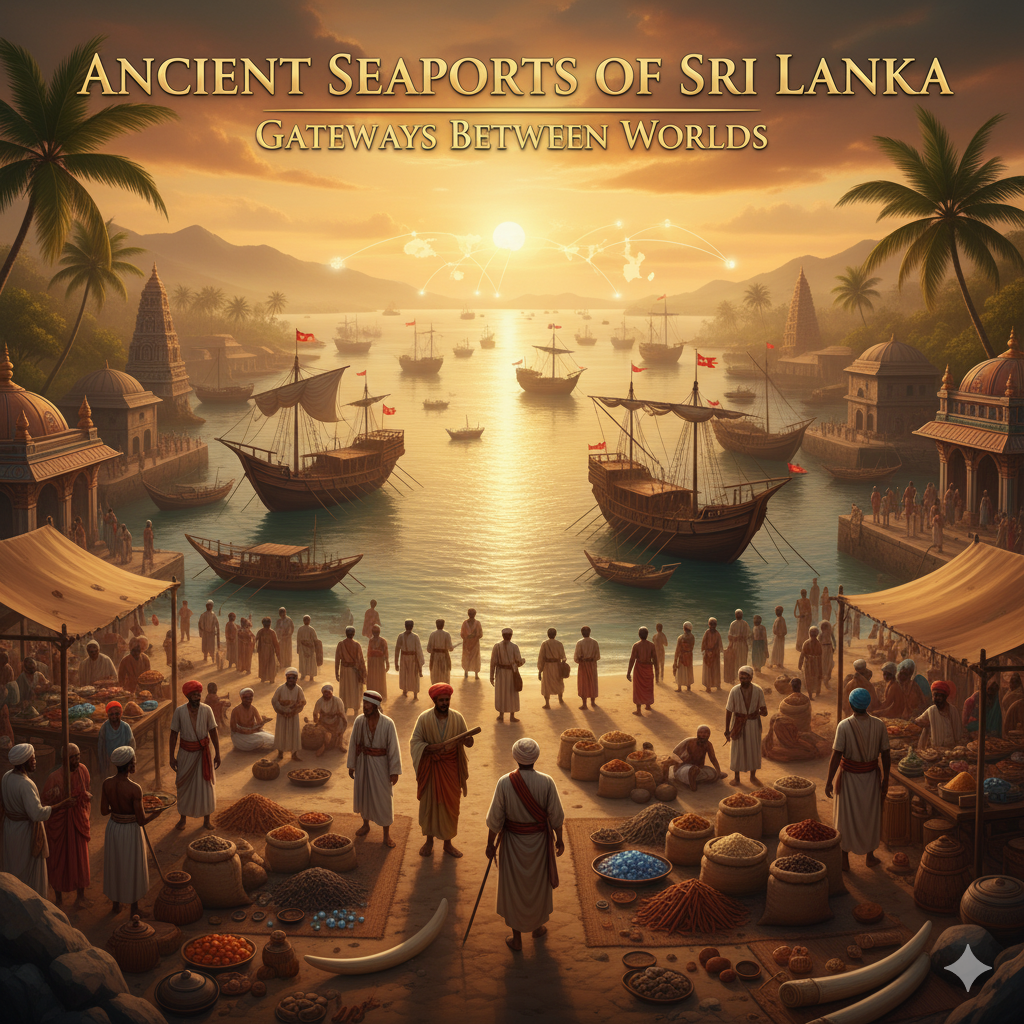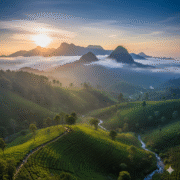
Ancient Seaports of Sri Lanka – Gateways Between Worlds
- November 12, 2025
- eunoialankatours
- 7:56 pm
Sri Lanka’s Ports and Maritime Heritage
Sri Lanka has been a beacon for travellers since the monsoon winds used to push ships onwards. Greek, Italian, Arabic, and Chinese writings all demonstrate that the island is like a pearl in the centre of the Indian Ocean. Its natural harbours provide safe harbour for ships from Europe, India, China, and the Arabian Peninsula. These harbour towns were cultural crossroads. For example, the 6th-century merchant Cosmas Indicopleustes called the western port of Mantai “the most important emporium” in the Indian Ocean. The water has never only caressed Sri Lanka’s beaches; it has brought stories, people, and ideas to its door.
Jambukola – Where Faith and Diplomacy Set Sail
Jambukola (now Kankesanturai) was on the northern extremity of the island, in the Jaffna peninsula. Old records say that it was the port to northern India, where ships from Bengal’s big port of Tamralipti could arrive. King Devanampiyatissa’s messengers left from here on their famous journey to the court of Emperor Ashoka in the 3rd century BCE. The king even made a route from the capital, Anuradhapura, to Jambukola so that religious and diplomatic missions could get to the coast conveniently.
Jambukola’s role was not just political. According to the Mahavamsa, the sapling of the sacred Bodhi tree from Bodh Gaya was transported to Sri Lanka by Theri Sanghamitta and landed at this port. Devanampiyatissa commemorated the event by erecting the Jambukola Vihara beside the harbour. For pilgrims and traders alike, the port was a liminal space where kingdoms met and the island’s new religion – Buddhism – first took root.
Mahatittha (Mantai) – Commercial Heart of the Silk Route
Further west, at the mouth of the Malwathu Oya, lay Mahātittha, known today as Mantai in Mannar. This harbour occupied the narrowest point between Sri Lanka and India. It was the main harbour on the island and played a dynamic role in the Maritime Silk Route, organising much of the country’s import-export economy. The Mahavamsa suggests that the port existed long before Aryan settlers arrived.
Archaeology shows its importance: a 40-foot-wide main road and Roman ceramics and coins have been unearthed, indicating Mediterranean trade. Ships left Mahātittha for ports on both the eastern and western sides of India. Early settlers, including King Vijaya and his followers, arrived through its waters. The harbour remained commercially active for centuries, trading pearls, precious stones, cinnamon, elephants, and other goods.
Gokanna/Trincomalee – A Natural Fortress
On the north-eastern coast, sailors found a very different harbour. Gokanna (present-day Trincomalee) is one of the world’s largest and safest natural harbours. Currents in the Bay of Bengal favoured voyages between the Indian subcontinent and South-East Asia, and the deep waters off Trincomalee were navigable year-round. Chronicles describe delegations sent by King Devanampiyatissa sailing from Gokanna to Emperor Ashoka’s court. Its strategic importance meant that the harbour remained active through successive eras, from ancient times to the colonial period and beyond.
Godavaya – Rock Harbour of the Maritime Silk Road
South-west of Hambantota, the Walawe River empties into the sea at a little fishing hamlet called Godavaya. Its name derives from goda pawatha pattana – “small rock harbour” – after the large rock overhanging the ocean. In the 2nd century CE, Godavaya served as a key stop on the Maritime Silk Road. Arab, Persian and Indian ships exchanged goods here, turning the harbour into a turntable of trade for East-West commerce. An inscription from King Gajabahu I records that customs duties collected at the port were used to support the nearby Buddhist monastery, making it one of the earliest documented customs offices in the world. Recent underwater excavations have uncovered a stone jetty, granite pillars, and a 2,000-year-old shipwreck.
Devinuwara (Dondra) – Temple Port at the Island’s Southern Tip
At the southernmost tip of Sri Lanka lies Devinuwara, also called Dondra. Today a quiet coastal town, it was once a thriving temple-port complex. A local chronicle notes that Devinuwara was a multi-religious pilgrimage and trading centre dedicated to Upulvan/Varuna (identified with Lord Vishnu) and maintained by Sinhalese kings and South Indian merchant guilds. At its zenith, it was famed for a thousand statues and attracted pilgrims from Southeast Asia, Northwest Africa, and Europe. Its harbour, near the Nilwala Ganga, served as an entrepôt for regional commerce and a gateway to the interior.
Galle – Cosmopolitan Hub of the South
Further along the southern coast lies Galle, renowned for its splendid natural harbour. Maritime archaeologists note that the port was used in pre-Christian times but gained importance after the 12th century; by the 14th century it had become Sri Lanka’s most important port. The great Chinese admiral Zheng He commemorated his visit by erecting a trilingual inscription in 1411 in Chinese, Tamil, and Arabic, hinting at the cosmopolitan mix of traders who used the port. Under Portuguese and Dutch rule, the town flourished further, and its fortified old town is now a World Heritage site.
Weligama, Bentota, and the Western Ports
Not all ports were grand entrepôts. Weligama (“sandy village”), a bay on the southern coast, was used by the Dutch East India Company as a guard post because of its favourable anchorage. Inland river mouths along the south-western coast – Bentota, Gintota, Kalutara, Wattala, Chilaw, and others – also harboured medieval trading centres. Literary sources attest that these ports flourished after the decline of the Chola empire, with Pandyan fleets contesting control during the reign of King Bhuvanekabāhu I (1284–1291). Their location at river mouths made it easy to move goods upriver into Sri Lanka’s interior.
Continuing the Seafaring Legacy – Modern Ports
- Colombo: South-west coast, largest and busiest port, handles over 7 million TEUs and ~30.9 million tonnes of cargo annually; ranked among world’s top 25 container ports.
- Hambantota: Southern coast, Sri Lanka’s second-largest port; specialises in roll-on/roll-off cargo, bulk goods, and LPG; recent expansions include oil-jetty and multipurpose terminal.
- Trincomalee: Natural harbour, focuses on bulk cargo such as cement, wheat, and petroleum; recognised as one of the world’s largest natural harbours.
- Galle: Hub for cruise and leisure traffic; cargo throughput ~21,500 TEUs; important for regional tourism and maritime activities.
A Living Heritage
Sri Lanka’s ancient seaports are more than ruins on a map; they are scenes of human endeavour. At Jambukola, courtiers once offered prayers before setting sail. At Mantai, traders haggled over pearls and cinnamon under customs officials’ watchful eyes. In Trincomalee, sailors prayed to the gods before braving the Bay of Bengal; in Godavaya, monks oversaw one of the oldest customs offices in the world. Devinuwara’s temple bells rang out across the waves, calling worshippers and merchants alike. Galle’s stone anchors and shipwrecks whisper of Chinese, Arab, and Dutch sailors who crossed paths there.
These stories remind us that Sri Lanka’s identity has always been interwoven with the sea. Contemporary ports continue that legacy, connecting this small island to a global network of trade and travel. Whether you stand by the calm waters of a ruined harbour or watch a container ship glide into Colombo, you are witnessing the same enduring dialogue between island and ocean. In Sri Lanka, the seafaring past is not a memory – it is a living, breathing part of everyday life.


